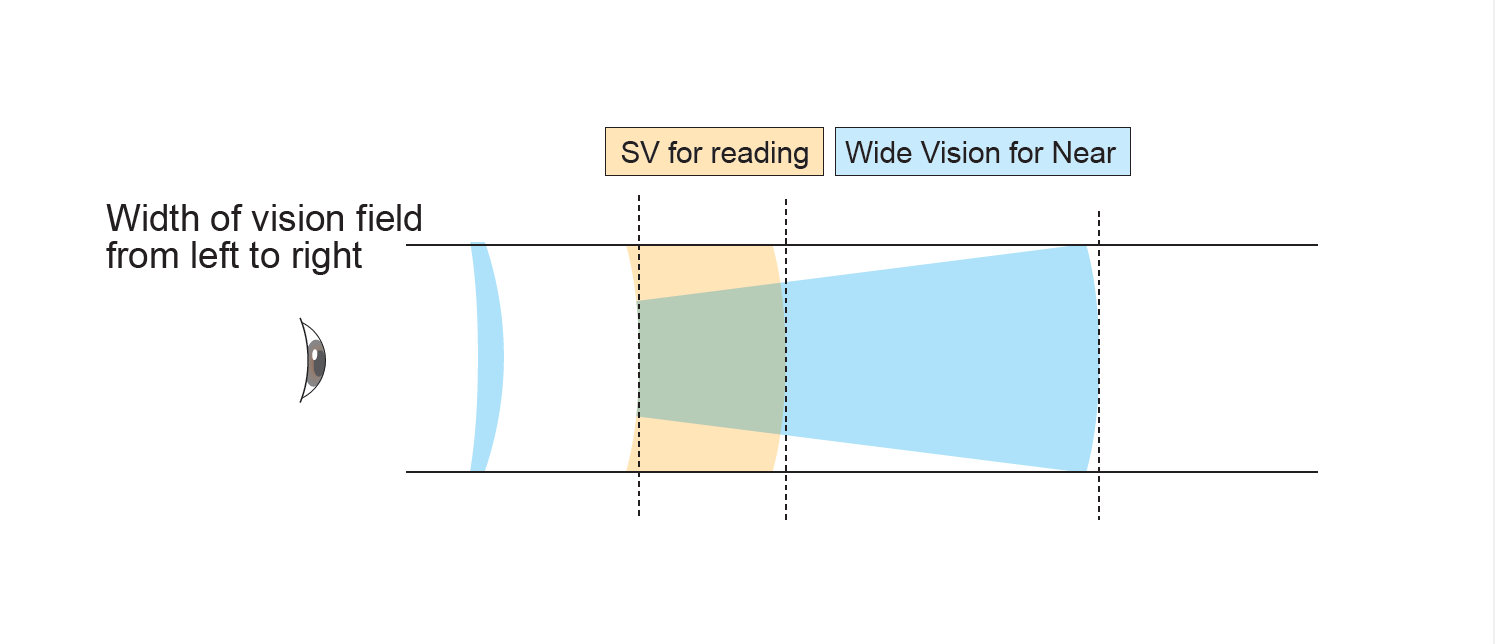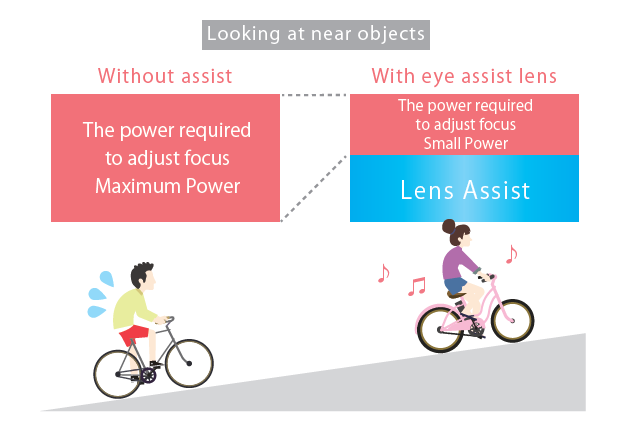This time, we would like to give some advice about the selection of eyeglass lenses suitable for people in their late 40s as How to select eyeglass lenses “suitable when using smartphones” (2).
Let’s start by reconfirming that this article is intended for those who suffer from troubles, such as:
- When I use my current progressive lenses, I need to look at my smartphone with my chin up, and this posture “really gives the impression that I have presbyopia.” I hate it. – C
- I have presbyopia, and it is therefore difficult for me to use a smartphone. – D
- I am concerned about harmful light, such as blue light. – E
*This is an excerpt from the previous article. As for A and B, please refer to (1).
Previous Article: Vol.7 Eyeglass lenses suitable for smartphones (1) (for people in their 20s, 30s, and early 40s)
While the key word in (1) was “fatigue,” it is “presbyopia” in this and subsequent articles.
(2) Difficulty of use due to “presbyopia” anyway
Today, it is said that nearly half of even the people in their 60s are using smartphones. And many people at the age of 70 and over are using smartphones freely. In this trend, each mobile phone carrier has started to concentrate efforts on support services for elderly people, and there is no doubt that these support services will be further expanded. However, no matter how far both support and hardware, including smartphone models, are expanded, it will not be easy to resolve the difficulty of use of smartphones due to presbyopia, and the number of people suffering from this trouble will increase in proportion to the rise of the ownership rate of smartphones.
Unfortunately, presbyopia is a kind of “aging-induced deterioration” nobody can avoid. Under conditions where an elderly person uses his/her smartphone, the person feels muscular fatigue resulting from eye focus adjustment, the inconvenience of putting on and taking off eyeglasses, screen glare, etc. in addition to this aging-induced deterioration. This situation is really “a hard time for him/her.” Let’s think about how to select eyeglass lenses that can alleviate such burdens even just a little bit.
First of all, what is different between the troubles of people in their 20s, people in their 30s, and people in their early 40s, which were described in the preceding article?
Take a look at the illustration below.

This illustration shows the “adjustable distance of focus at each age.” It may be easier for you to understand it as the limit point of the distance one can see near objects. For example, “14 cm” is the limit point for people in their 30s. These people can view smartphone screens considerably clearly from this distance. The limit point for people in their 40s is “20 cm.” As mentioned in the preceding article, it is said that the average distance of viewing websites on a smartphone is 20 cm. This means that these people can manage to view smartphone screens although they are very close to the limit.
From this point, the adjustable distance of focus drastically changes. Take a look at the data on 45-year-old people. You can see that “40 cm” is the limit point. Needless to say, it depends on the individual, but from around this age, vision for near objects will become deteriorated exponentially, which means that presbyopia will progress. At the age of around 50, the limit point increases to “67 cm.” This distance is almost equal to the full reach of an adult male’s arm. You do not think it can be said to be “near,” do you? People having good eyesight (emmetropia or hyperopia) will become unable to view near objects more and more. And people having bad eyesight (myopia) cannot focus their eyes at all unless they take off their eyeglasses (contact lenses).
In this condition, it is difficult to correct their eyes with the idea of “assisting” the function of the muscles. If you can see objects clearly from a distance of 40 cm, even the “assist lenses” introduced in (1) help the eyes focus on objects from a distance of about 30 cm but are not designed to cover the close distance at which people use smartphones, and people will feel unsatisfactory with these lenses soon because of the progress of presbyopia.
In such a situation, progressive lenses, after all, are the first choice as eyeglass lenses for smartphones.
You may think, “What? progressive lenses after all …” However, considering eyeglass lenses tailored to “smartphones,” you can select progressive lenses with a justifiable reason, and the eyeglass lenses we can recommend depend on the age.
○ Recommendations to people in their late 40s
First of all, we consider what we can recommend to those who are reaching late 40s and have started to feel it difficult to see near objects.
Many of them are aware of having presbyopia but cannot help but force themselves to do everything in the same manner as before from a strong consciousness that “I do not want my presbyopia to be noticed by people around me” or “I do not want to accept presbyopia.” We can understand their feelings because, to tell the truth, even many employees of us, an eyeglass lens manufacturer, think in the same manner.
Their feelings are exactly the same as “C. When I use my current progressive lenses, I need to look at my smartphone with my chin up, and this posture ‘really gives the impression that I have presbyopia.’ I hate it.” as mentioned at the top of this article. So, let’s think this trouble from this standpoint.

This is probably because this distance ensures a good balance between far vision, near vision, sway, and distortion.
A progressive lens consists of “an upper part for far vision and a lower part for near vision.” In general, many progressive lenses currently available on the market are designed with this movement distance of the line of vision from the upper part to the lower part (corridor length) of approximately 13 mm. A progressive lens consists of “an upper part for far vision and a lower part for near vision.”
In general, many progressive lenses currently available on the market are designed with this movement distance of the line of vision from the upper part to the lower part (corridor length) of approximately 13 mm.
Certainly, progressive lenses may be the best lenses as daily-use eyeglass lenses. However, the longer this movement distance, the farther the position from where one sees near objects.
Take a look at (1) and (2) in the illustration shown above. (Assuming that (1) is the general distance of approximately 13 mm.) You can see that the position of the pupil of (1) is considerably lower than (2).
You feel pretty hard if you try to move your eyes as shown in the illustration. Instead of moving the line of vision all the way down, raise your chin to move the position of the line of vision. This posture makes you appear to “really have presbyopia.”
Contrary to it, the movement distance of the line of vision of (2) is as short as 9 mm, which is a considerably natural state. In ergonomics, it is said that the angle of looking down naturally is approximately 20 degrees, and this angle corresponds to approximately 9 mm in the movement distance of the line of vision.
One of our products, “ClairArte,” also has a movement distance of 9 mm of the line of vision (corridor length).
*For details, click here: ClairArte
A lens having a short corridor length enables the user to obtain appropriate “power to adjust focus to near objects” by only looking down naturally, and the user no longer needs to adjust the position of the line of vision by raising his/her chin and can avoid appearing to “really have presbyopia.” In addition, many people in this generation can be said to be “beginners” in the use of progressive lenses.
Although progressive lenses are very convenient, it is necessary to get used to them and learn knacks of using them.
One of them is “how to use the line of vision.”
As shown in the illustration above, the area for near vision of a general progressive lens is set in an unexpectedly low position. Thus, it is necessary to get used to seeing things in an optimum position, and the posture of simply “raising one’s chin” is not easy. In this context also, we can recommend lenses having a short corridor length of, for example, 9 mm.
However, progressive lenses also have disadvantages.
Since the power of a progressive lens changes successively from the top to the bottom, it gives the user a strange feeling as he/she moves the line of vision.
It is a so-called feeling of “being lightheaded.” This strange feeling intensifies as the movement distance of the line of vision (corridor length) decreases. If the same change in power is set in corridor lengths of 13 mm and 9 mm, one feels the power changing more sharply in the 9-mm corridor length than in the the 13-mm corridor length. Do you understand it? It is just like an image that the “steps of the change” become sharp and change abruptly!
This feeling may be unbearable to sensitive people and people who use progressive lenses for the first time. c, the convenience of progressive lenses greatly changes depending on the lifestyle of an individual when they are regularly used. You are advised to consult an eyeglass store with these points kept in mind.However, the abovementioned disadvantages are much less unbearable to people in their late 40s, who are at the initial stage of presbyopia, because the change in power is still small, and the “steps of the change” are gradual.
Thus, these people will be able to get used to them more easily than when you start to use them after presbyopia has become worse. Also from this aspect, progressive lenses are easy to recommend to people in their late 40s.
In addition, if you can afford and understand the need to change eyeglass lenses at a shorter interval, it may be advisable as another approach to try first “assist lenses” introduced in the preceding article earlier, and then change them to progressive lenses when you feel dissatisfied with assist lenses.
As mentioned earlier, it is necessary for beginners in the use of progressive lenses to get used to them first. “Assist lenses” also have a change in power and are similar to progressive lenses in structure. However, this change in power is extremely gradual, and the feeling of the movement of the line of vision is also mild. Thus, assist lenses are optimum in that it is easy for people to “get used to the change.”
Please consider this approach as an option.
This is the end of this article. In the next article, we are going to give some advice about the selection of eyeglass lenses for people in their 50s.





